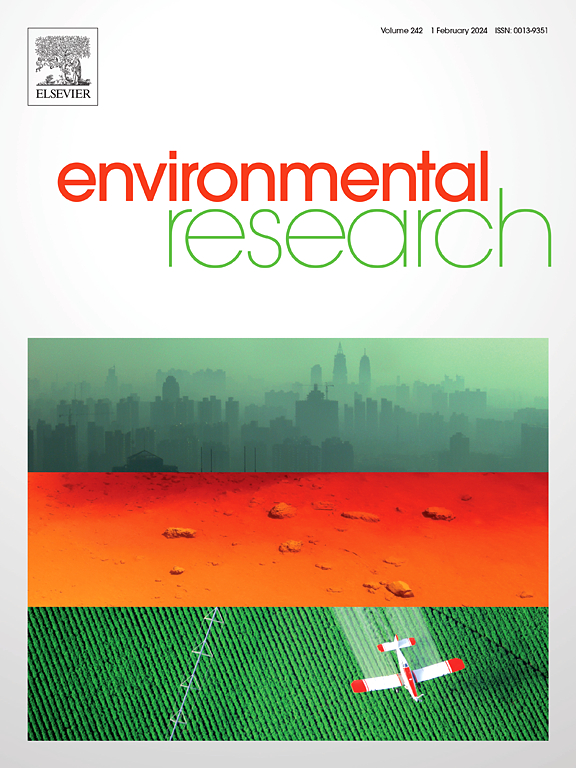从热电厂产生的废物中开发的吸附剂去除新出现的污染物:吸附和生态毒理学研究
IF 7.7
2区 环境科学与生态学
Q1 ENVIRONMENTAL SCIENCES
引用次数: 0
摘要
越来越多的药物使用和不当处置造成了重大的环境影响。传统的处理方法在工业规模上面临挑战,而大量的低成本吸附剂(如残留物)为药物去除提供了可持续的选择。以某热电厂水处理系统产生的污泥为原料,研制了一种吸附剂。用十二烷基三甲基氯化铵(DTAC)对前驱体进行化学改性,并将其命名为化学改性残渣(CMR)。CMR用于从水溶液中去除布洛芬、双氯芬酸钠和氯沙坦钾。采用SEM, FTIR, XRD, TG,氮气吸附-解吸,PZC, XRF, CHN和XPS进行表征。XRF显示Si、Al和Fe为主要元素。XPS分析鉴定出表面化学键包括C-C、C-OH、C-O-C、Si-C和氮。FTIR分析显示了与Si-O - si、Si-O - al、Si-O、Si-OH和CH2相关的振动带。XRD鉴定出SiO2和NaAlSi3O8等晶相。经DTAC改性后,去除率提高了70%以上。氯沙坦的最大吸附量为101.43 mg g−1,双氯芬酸为73.77 mg g−1,布洛芬为24.81 mg g−1,表明该体系具有去除这些化合物的潜力。使用药物溶液进行生态毒性试验,双氯芬酸、氯沙坦和布洛芬的EC50、48小时值分别为24.11、175.50和53.92 mg L−1。这些结果表明,CMR是一种有效的低成本吸附剂,用于药物去除,促进废物再利用和减少环境影响。本文章由计算机程序翻译,如有差异,请以英文原文为准。

Removal of emerging pollutants by an adsorbent developed from a waste produced in a thermoelectric power plant: adsorption and ecotoxicological studies
The increasing use and improper disposal of pharmaceuticals have caused significant environmental impacts. Conventional treatment methods face challenges at the industrial scale, whereas abundant, low-cost adsorbents such as residues offer a sustainable alternative for pharmaceutical removal. In this study, an adsorbent was developed from sludge generated by the water treatment system of a thermoelectric power plant. The precursor was chemically modified with dodecyltrimethylammonium chloride (DTAC) and designated as chemically modified residue (CMR). The CMR was applied for the removal of ibuprofen, sodium diclofenac, and potassium losartan from aqueous solutions. Characterization was performed using SEM, FTIR, XRD, TG, nitrogen adsorption–desorption, PZC, XRF, CHN, and XPS. XRF revealed Si, Al, and Fe as the predominant elements. XPS analysis identified surface chemical bonds including C–C, C–OH, C–O–C, Si–C, and nitrogen species. FTIR analysis revealed vibrational bands associated with Si–O–Si, Si–O–Al, Si–O, Si–OH, and CH2. XRD identified crystalline phases such as SiO2 and NaAlSi3O8. Modification with DTAC led to an improvement in removal efficiency, with values exceeding 70.00 %. The maximum experimental adsorption capacities were 101.43 mg g−1 for losartan, 73.77 mg g−1 for diclofenac, and 24.81 mg g−1 for ibuprofen, demonstrating the system's potential to remove these compounds. Ecotoxicity tests using pharmaceutical solutions resulted in EC50,48h values of 24.11, 175.50, and 53.92 mg L−1 for diclofenac, losartan and ibuprofen, respectively. These results demonstrate that CMR is an effective and low-cost adsorbent for pharmaceutical removal, promoting waste reuse and reducing environmental impact.
求助全文
通过发布文献求助,成功后即可免费获取论文全文。
去求助
来源期刊

Environmental Research
环境科学-公共卫生、环境卫生与职业卫生
CiteScore
12.60
自引率
8.40%
发文量
2480
审稿时长
4.7 months
期刊介绍:
The Environmental Research journal presents a broad range of interdisciplinary research, focused on addressing worldwide environmental concerns and featuring innovative findings. Our publication strives to explore relevant anthropogenic issues across various environmental sectors, showcasing practical applications in real-life settings.
 求助内容:
求助内容: 应助结果提醒方式:
应助结果提醒方式:


